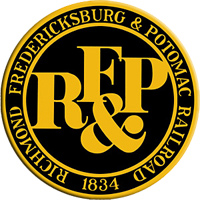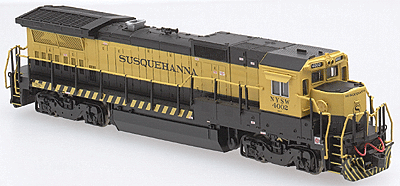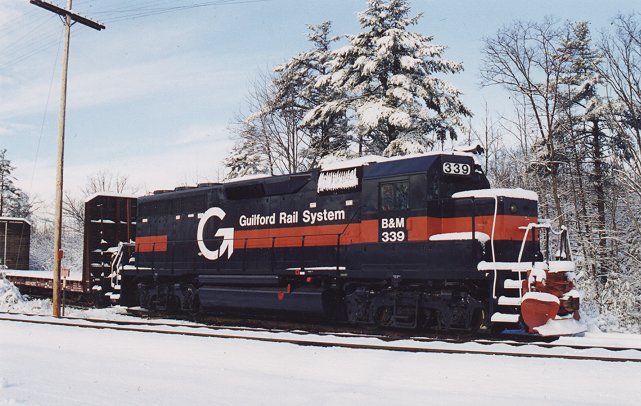Model Information: This model was first introduced by Atlas in 1969. This early version was made for Atlas by Mehano in Yugosolvia. It was later retooled and moved to Chinese production in 1996. It was later revised with a DCC-Ready chassis in 2003. The same mechanism is used for the GP38, GP38-2, GP40 and GP40-2.
The earliest (Mehano) releases only came as GP-40's. The other versions (GP38, GP38-2 and GP40-2) only arrived later after the production was moved to China.
Both of the Chinese mechanisms run fine but the first releases (1996) do not support drop in decoders. Both versions use a dual-flywheel, split frame chassis with a 5-Pole skew-wound motor.
The current model features:
The earliest (Mehano) releases only came as GP-40's. The other versions (GP38, GP38-2 and GP40-2) only arrived later after the production was moved to China.
Both of the Chinese mechanisms run fine but the first releases (1996) do not support drop in decoders. Both versions use a dual-flywheel, split frame chassis with a 5-Pole skew-wound motor.
The current model features:
- Golden-white LEDs;
- Separately-applied roof detail;
- Painted safety rails;
- Directional lighting;
- Blackened metal wheels;
- Scale Speed motor;
- Separately-applied coupler cut levers;
- Non-Dynamic, Dynamic, and Extended Range Dynamic Brakes used where appropriate;
- Pilot: Standard or with Snow Plow;
- Low short hood and High short hood versions available.
DCC Information: The Mehano versions do not support DCC at all. Early Chinese versions are DCC-friendly requiring a complicated split-board DCC install. Later versions are DCC-Ready accepting a 1 Amp N Scale Mobile Decoder for Atlas N-Scale GP40-2, U25B, SD35, Trainmaster, B23-7 and others (DN163A0) from Digitrax.
Unfortunately, the only way to tell which kind you have is to remove the shell and check the chassis. If it has two small lightboards, you have an old one in your hand. A single long lightboard indicates a DCC-Ready chassis.
Unfortunately, the only way to tell which kind you have is to remove the shell and check the chassis. If it has two small lightboards, you have an old one in your hand. A single long lightboard indicates a DCC-Ready chassis.
Prototype History: The GP40 is a 4-axle diesel-electric road-switcher locomotive built by General Motors, Electro-Motive Division between November 1965 and December 1971. It has an EMD 645E3 16-cylinder engine generating 3,000 hp (2,240 kW).
The GP40 is 3 feet (0.914 m) longer than its EMD 567D3A-engined predecessor, the GP35, and distinguished visually by its three 48-inch radiator fans at the rear of the long hood, while the GP35 has two large fans and a smaller one in between. It was built on a 55 ft (16.76 m) frame; the GP35 was built on a 52 ft (15.85 m) frame - as was the GP7, 9, 18, and 30. The difference in length can be seen in the GP40's ten handrail stanchions compared to the GP35's nine.
1,187 GP40s were built for 28 U.S. railroads; 16 were built for one Canadian carrier, Canadian National; and 18 were built for two Mexican carriers, Ferrocarril Chihuahua al Pacifico and Ferrocarriles Nacional de Mexico. 60 units were built with high-short-hoods and dual control stands for Norfolk & Western Railway. Two passenger versions, the GP40P and GP40TC, were also built, but on longer frames to accommodate steam generators and HEP equipment.
On January 1, 1972, the GP40 was discontinued and replaced by the GP40-2, which has a modular electrical system and a few minor exterior changes.
From Wikipedia
A Guilford/Pan Am (MEC) train headed by a high-nose GP40 ex-NW followed by two SD40M-2 (rebuilt SD45)
The GP40 is 3 feet (0.914 m) longer than its EMD 567D3A-engined predecessor, the GP35, and distinguished visually by its three 48-inch radiator fans at the rear of the long hood, while the GP35 has two large fans and a smaller one in between. It was built on a 55 ft (16.76 m) frame; the GP35 was built on a 52 ft (15.85 m) frame - as was the GP7, 9, 18, and 30. The difference in length can be seen in the GP40's ten handrail stanchions compared to the GP35's nine.
1,187 GP40s were built for 28 U.S. railroads; 16 were built for one Canadian carrier, Canadian National; and 18 were built for two Mexican carriers, Ferrocarril Chihuahua al Pacifico and Ferrocarriles Nacional de Mexico. 60 units were built with high-short-hoods and dual control stands for Norfolk & Western Railway. Two passenger versions, the GP40P and GP40TC, were also built, but on longer frames to accommodate steam generators and HEP equipment.
On January 1, 1972, the GP40 was discontinued and replaced by the GP40-2, which has a modular electrical system and a few minor exterior changes.
From Wikipedia
A Guilford/Pan Am (MEC) train headed by a high-nose GP40 ex-NW followed by two SD40M-2 (rebuilt SD45)
Road Name History: The RF&P ran from Richmond, Virginia north 114 miles to Potomac Yard (known widely as Pot Yard) on the river near Washington D.C. The purpose of the line was to link the Pennsylvania Railroad and Baltimore & Ohio lines to the northeast with the Seaboard Air Line and Atlantic Coast Line lines to the south. There were few branchlines of consequence and the mainline was entirely double tracked with no grades to speak of. It was operated as a single route as early as 1901 although the route north of Quantico actually belonged to a PRR subsidiary called the Washington Southern. RF&P absorbed the Washington Southern in 1920. There were also connections with Southern and C&O but C&O traffic in the area was almost entirely east-west and Southern had their own line to Washington D.C.
Traffic was heavy and fast. Pacifics were used for freight and passenger service. These were supplanted by 4-8-2 Mountains then by Northerns and Berkshires. Aside from some Alco switchers, RF&P was an entirely EMD road in the diesel era. E8’s and FP7’s hauled the passengers (mostly PRR, SAL and ACL trains) while F5’s and F7’s hauled freight with GP7’s in support. The second generation brought GP35’s, and GP40’s for road service. The diesel fleet usually ran just under 40 units for the 114 mile line (indicating very heavy traffic.) As a rule, even numbered units faced north and odd numbered units faced south. Road switchers were equipped with dual cab controls and running long hood forward was common.
By 1987, RF&P’s situation had changed. The former PRR connection had mostly faded as Amtrak operated the line to the northeast and not Conrail. That left the former B&O on the north end and the former Seaboard System on the south end. Both were now part of CSX. RF&P was still a vital link but it didn’t make sense to be a separate railroad. CSX already owned much of the stock but a quarter of the shares of RF&P were owned by the state of Virginia’s state employee retirement fund. In the end, CSX gave the state fund the property rights to Potomac Yard in exchange for all of the stock. Pot Yard originated or terminated very little traffic with nearly every train just running through so the property was ripe for development. In fact there was talk of turning part of the property into a new stadium for the Washington Redskins. In the end, it became commercial property instead. The state was happy and CSX closed the gap on their system map. RF&P merged into CSX in 1991.
Traffic was heavy and fast. Pacifics were used for freight and passenger service. These were supplanted by 4-8-2 Mountains then by Northerns and Berkshires. Aside from some Alco switchers, RF&P was an entirely EMD road in the diesel era. E8’s and FP7’s hauled the passengers (mostly PRR, SAL and ACL trains) while F5’s and F7’s hauled freight with GP7’s in support. The second generation brought GP35’s, and GP40’s for road service. The diesel fleet usually ran just under 40 units for the 114 mile line (indicating very heavy traffic.) As a rule, even numbered units faced north and odd numbered units faced south. Road switchers were equipped with dual cab controls and running long hood forward was common.
By 1987, RF&P’s situation had changed. The former PRR connection had mostly faded as Amtrak operated the line to the northeast and not Conrail. That left the former B&O on the north end and the former Seaboard System on the south end. Both were now part of CSX. RF&P was still a vital link but it didn’t make sense to be a separate railroad. CSX already owned much of the stock but a quarter of the shares of RF&P were owned by the state of Virginia’s state employee retirement fund. In the end, CSX gave the state fund the property rights to Potomac Yard in exchange for all of the stock. Pot Yard originated or terminated very little traffic with nearly every train just running through so the property was ripe for development. In fact there was talk of turning part of the property into a new stadium for the Washington Redskins. In the end, it became commercial property instead. The state was happy and CSX closed the gap on their system map. RF&P merged into CSX in 1991.
Brand/Importer Information: In 1924 Stephan Schaffan, Sr. founded the Atlas Tool Company in Newark, New Jersey. In 1933 his son, Stephan Schaffan, Jr., came to work for his father at the age of sixteen. Steve Jr. built model airplanes as a hobby and frequented a local hobby shop. Being an enterprising young man, he would often ask the owner if there was anything he could do to earn some extra spending money. Tired of listening to his requests, the hobby-store owner threw some model railroad track parts his way and said, "Here, see if you can improve on this".
In those days, railroad modelers had to assemble and build everything from scratch. Steve Jr. created a "switch kit" which sold so well, that the entire family worked on them in the basement at night, while doing business as usual in the machine shop during the day.
Subsequently, Steve Jr. engineered the stapling of rail to fiber track, along with inventing the first practical rail joiner and pre-assembled turnouts and flexible track. All of these products, and more, helped to popularize model railroading and assisted in the creation of a mass-market hobby. The budding entrepreneur quickly outgrew the limitations of a basement and small garage operation. Realizing they could actually make a living selling track and related products, Steve and his father had the first factory built in Hillside, New Jersey at 413 Florence Avenue in 1947. On September 30, 1949, the Atlas Tool Company was officially incorporated as a New Jersey company.
In 1985, Steve was honored posthumously for his inventions by the Model Railroad Industry Association and was inducted into the Model Railroad Industry Hall of Fame in Baltimore, Maryland. In addition, Steve was nominated and entered into the National Model Railroad Association Pioneers of Model Railroading in 1995.
In the early 1990s, the Atlas Tool Company changed its name to Atlas Model Railroad Company, Inc.
In those days, railroad modelers had to assemble and build everything from scratch. Steve Jr. created a "switch kit" which sold so well, that the entire family worked on them in the basement at night, while doing business as usual in the machine shop during the day.
Subsequently, Steve Jr. engineered the stapling of rail to fiber track, along with inventing the first practical rail joiner and pre-assembled turnouts and flexible track. All of these products, and more, helped to popularize model railroading and assisted in the creation of a mass-market hobby. The budding entrepreneur quickly outgrew the limitations of a basement and small garage operation. Realizing they could actually make a living selling track and related products, Steve and his father had the first factory built in Hillside, New Jersey at 413 Florence Avenue in 1947. On September 30, 1949, the Atlas Tool Company was officially incorporated as a New Jersey company.
In 1985, Steve was honored posthumously for his inventions by the Model Railroad Industry Association and was inducted into the Model Railroad Industry Hall of Fame in Baltimore, Maryland. In addition, Steve was nominated and entered into the National Model Railroad Association Pioneers of Model Railroading in 1995.
In the early 1990s, the Atlas Tool Company changed its name to Atlas Model Railroad Company, Inc.
Item created by: Steve German on 2016-04-11 17:06:47. Last edited by Lethe on 2020-05-07 00:00:00
If you see errors or missing data in this entry, please feel free to log in and edit it. Anyone with a Gmail account can log in instantly.
If you see errors or missing data in this entry, please feel free to log in and edit it. Anyone with a Gmail account can log in instantly.











